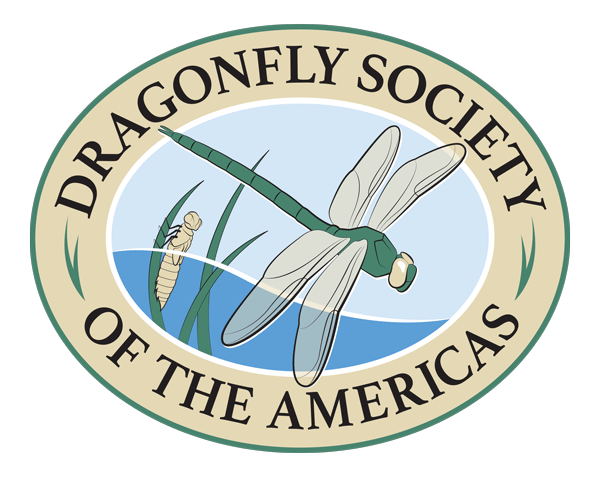April Species of the Month: Exclamation Damsel (Zoniagrion exclamationis)
Exclamation Damsel (Zoniagrion exclamationis) Sebastopol, Sonoma County, California. Photo by Dave Biggs (2014)
Our April DSA species of the month is the Exclamation Damsel (Zoniagrion exclamationis) in the family Coenagrionidae. Size-wise, its length is 33-35 mm (just under one-and-a-half inches). It is also the lone species in the genus Zoniagrion. The damselfly is a California endemic with two blue exclamation marks on top of the thorax and jaunty blue eyespots. Males have dark abdomens with blue on S7-9, while females only have blue on S8-9. Exclamation Damsels breed in mud-lined creeks, and may be found in wooded streams. Join dragonfly chaser Kathy Biggs as she tells about her encounter with this species, and how it changed how dragonfly chasers learn about it today.
How the Exclamation Damsel Got Its Common Name
Back in the very early days of dragonflies, species only had scientific names. In November of 1996, the Dragonfly Society of the Americas naming committee came up with English common names that the membership could vote on. One of those common names kept me from making my very first Odonata identification. But then I, very much a newbie, helped give a common name to a species.
I live just an hour north of San Francisco and about 12 miles from the Pacific Coast. In 1996, I studied the dragonflies at my newly created wildlife pond. By 1997, armed with the new list of common names, I decided to look for some odonates at a nearby park.
The first day of looking for dragonflies, I found a Forktail-like damselfly (Ischnura) with blue on the thorax and a dark abdomen with a blue ‘tail’ that even to my beginner’s eyes looked quite a bit larger than the Forktails at my backyard pond. What could it be?
Female Exclamation Damsel (Zoniagrion exclamationis), Sonoma County, California. Photo by Jim Burns (June, 2018).
Looking at my list of California dragonflies, I found Dancers. Nope, couldn’t be a dancer, too much blue color. Bluets? Nope, couldn’t be a bluet, too much blue on them also. Forktails? Too small. Then, there was the Sierra Damsel. Nope, I wasn’t in the Sierras. I was in a lowland area.
I was baffled, what could it be?
Dennis Paulson had seen my pond list of dragonflies online and had sent me one gentle correction. My Powdered Dancer (Argia moesta) was more likely a mature female Western Forktail (Ischnura perparva), he told me. Aha! Dennis might be able to identify my unknown damsel! I contacted him, and he told me that it was the Sierra Damsel (Zoniagrion exclamationis).
I felt miffed! The common name had thrown me astray. I complained to Dennis about it. He then said something to the effect of I’m on the naming committee and this first year the committee will entertain any suggested changes. He encouraged we Californians to come up with a more suitable new common name.
My husband Dave, Tim Manolis, Andy Rehn, and myself started thinking about names. We realized that to non-Californians, the name “Sierra” brought to mind our state. But to us, it meant high mountains. And this was not a mountain species.
Female Exclamation Damsel (Zoniagrion exclamationis), Sonoma County, California. Photo by Bob Berhstock. (1999)
As we searched for a likely name, it turned out that each name we chose was already taken. Shadow Damsel? Zoniagrion exclamationis likes dappled shade, but Shadow Damsel was already in use for Palaemnema domina. Other names just didn’t seem right.
Finally, we realized that this damselfly has two blue exclamation marks atop its thorax. Its scientific name includes “exclamationis.” Why not name it the Exclamation Damsel? It was a mouthful, but we submitted it anyway. Then, we waited. The vote wasn’t unanimous, but the name “Exclamation Damsel” prevailed. I was so excited!
Now, I can say I’ve had a role in naming a gorgeous damselfly.
Kathy Biggs, Sonoma County, California. Photo by Dave Biggs. (2000)
Our guest blogger for April is Kathy Biggs, who has been a nature lover all her life. When she built a wildlife pond in her Sebastopol, California backyard in 1996, dragonflies arrived and she found her true passion. Wanting to share her passion, she developed websites for her wildlife ponds, California Dragonflies, Southwest Dragonflies and most recently A First Guide to the Dragonflies of Jalisco. The websites matured and grew into Kathy's becoming the author of California’s first Dragonfly Guide, Common Dragonflies of California, the Southwest’s first dragonfly guide, Common Dragonflies of Southwest, a dragonfly color and learn book and her latest publication, Dragonflies of the Greater Southwest. Kathy manages the Groups CalOdes and Building Ponds for Wildlife. Kathy is the vetter for California on Odonata Central, and iNaturalist California and Jalisco, MX. She hopes she can inspire you to get to know the dragonflies and the wetlands that support them.





